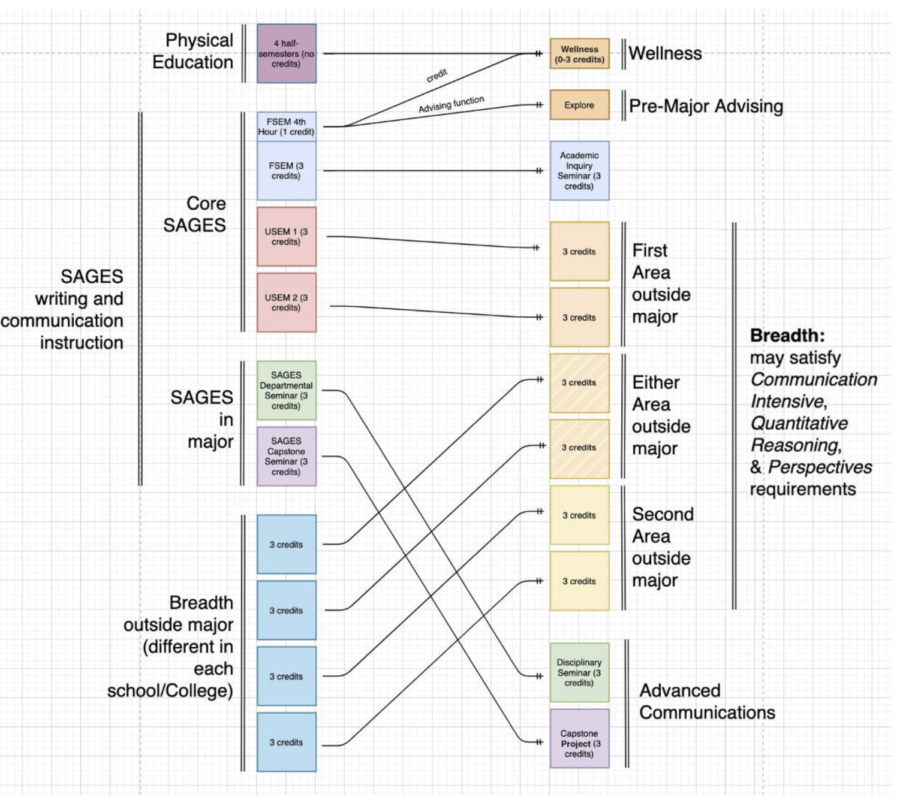SAGES is ending next semester. But what’s actually changing?
CWRU is eliminating the SAGES program and replacing it with Unified General Educational Requirements (UGER) in the hopes that students will have greater flexibility to explore classes in departments across the university.
March 24, 2023
Since 2003, students at Case Western Reserve University have been required to take courses within the Seminar Approach to General Education and Scholarship (SAGES) sequence. Forming the basis of CWRU’s undergraduate curriculum, SAGES classes are seminar-style courses meant to teach students the basics of writing. This educational process occurs over three total classes, which begin the first semester during a student’s first year. For decades, SAGES has been an essential component of a CWRU education, as it forms a universal experience for all students. That’s all about to change as CWRU plans on phasing out the SAGES program and introducing new Unified General Education Requirements (UGER) in fall 2023.
The new UGER keeps the same overall values and format of the SAGES program but aims to give students more flexibility in choosing their electives and more exposure to academic departments throughout CWRU. In essence, the changes broaden breadth requirements for students by moving SAGES-type courses directly under specific academic departments rather than having their own classification.
The one exception is the introductory freshman writing course, which will remain pretty much the same. The current four-credit SAGES “First Seminar” will transition into a three-credit “Academic Inquiry Seminar.” The new introductory seminar will have similar goals to current First Seminar classes but students can take it their first or second semester at CWRU, theoretically allowing for more flexibility in what courses students wish to take. Academic Inquiry Seminars will continue to be provided on an array of topics, though they won’t be under any specific department. The intermediate SAGES courses, currently known as “University Seminars,” will be transitioned into academic departments with the label of “Communication Intensive” courses, of which students will still have to take two. By being under specific academic departments, students can use these courses to fulfill major, minor or breadth requirements that they may have.
There will now be a single breadth requirement of 18 credits, which students will have to take between three categories of “STEM,” which consists of all natural and mathematical science courses in the College of Arts and Sciences, all engineering courses and all nursing courses; “Social Sciences and Management,” which consists of all social sciences in the College and all Weatherhead courses; and “Humanities and Arts,” which consists of all humanities and arts courses in the College. If someone’s primary major is in one of these categories, students will have to take at least two courses in each of the other two areas, along with two additional courses in either non-major area. These breadth courses may include either or both of a student’s “Communication Intensive” courses or courses that fulfill other UGER requirements.
These new Academic Inquiry Seminars will be taught by a new group of adjunct faculty lecturers from the Department of English that the university claims “will have greater stability than the SAGES lecturer positions were able to have.” CWRU also asserts that they expect most SAGES lecturers to continue teaching with the new UGER.
With the move of these mandatory courses to be under specific academic departments, CWRU hopes that students will be able to explore more departments across the university outside their major, hopefully allowing them to pursue new interests. A side effect of this change will be an increase in enrollments occurring in humanities classes in the College of Arts and Sciences directly. This will theoretically allow the College to increase its budget as CWRU allocates undergraduate tuition revenue depending on enrollments to each school under CWRU, which includes the College, the Case School of Engineering and the Weatherhead School of Management. How this change exactly plays out remains to be seen, but CWRU has committed to ensuring that no school is budgetarily worse off due to the new UGER.
Other changes outside of SAGES include the physical education (PE) requirement being transitioned into a general “Wellness” requirement. Students will be able to take cooking, psychological wellness and financial wellness classes to fulfill the requirement rather than strictly PE courses. The SAGES Departmental Seminars and Capstone Seminars will mostly remain the same but will be renamed to “Disciplinary Seminars” and “Capstone Project Courses,” though CWRU notes that some departments may alter their offerings for these courses. A writing portfolio will still be required, though the requirements will be adjusted for the new curriculum. Students will also be participating in an “Explore” program to help them find out more about other academic departments, university resources and Cleveland’s cultural institutions they might not otherwise have exposure to. The exact details of this program have not yet been determined, though.
Also unclear are the exact class sizes of these courses. SAGES First Seminar courses were capped at 17 students, and similarly Academic Inquiry Seminars will be capped at 16 students. The amount of students per Communication Intensive class still remains unclear as the university tries to find the “optimal equilibrium,” but generally these classes may be larger than current SAGES courses if they can be broken down into smaller sections of 18 or so.
Students currently enrolled at CWRU will not have the new UGER but rather will continue under the current system. SAGES courses will continue to exist for the next two years but continuing students will also have the option to supplement their requirements with the new equivalents. Students needing a SAGES Natural World (USNA) course can take a Communication Intensive course under a STEM department, students needing a SAGES Social World (USSO) course can take a Communication Intensive course under a Social Science or Management department and students needing a SAGES Symbolic World (USSY) course can take a Communication Intensive course under a humanities or arts department. These new SAGES substitutes notably cannot be used to fulfill breadth requirements for returning students as they can under the new system that incoming students will use. The newer broader Wellness courses, however, can be used to fulfill existing PE requirements.
Another major change is that First Seminar professors will no longer act as pre-major academic advisors. Students under the new UGER will now be matched with a faculty member “with whom they share some academic interest (potential major, minor, or field of interest).” How this matching process works is not entirely clear but incoming students will meet with their Navigator to choose their first-semester courses, after which they will be paired with an advisor who they will keep until they receive a major advisor.
SAGES was first created in order for CWRU students to have introductory classes with small class sizes and to create a universal curriculum across campus. At the time, professors complained of excessively large class sizes for their introductory courses within their departments’ course sequences, leading to teaching not being as effective for essential skills. While the new UGER will be moving essential writing courses under various departments, CWRU hopes to build off of the SAGES program’s values while adding flexibility.
Peter Shulman, associate professor of history, and past chair of the Faculty Senate and Faculty Senate Committee on Undergraduate Education, was involved in the development of the new curriculum and commented on the need to adjust our current educational requirements.
“One intention in designing this new [UGER] has been to try to prevent problematic unintended consequences like excessively large classes,” Shulman said. “In part, that involved careful consideration of how these changes would actually look for students and for the institution, and this involved a considerable amount of enrollment and budgetary modeling—we wanted the program to be driven by data and evidence. Still, it’s inevitable that some unexpected results might happen, which is why we built in regular reviews of how things are running as well as clear mechanisms for the faculty to adjust the program if the need arises.”
CWRU began planning these changes in January 2016, though planning has continued until this day. First, a commission was formed by the Office of the Provost to reevaluate the undergraduate experience, which identified potential areas of improvement for two years before giving their recommendations. After handing in their report to the provost and faculty in May 2018, plans for implementation began as the Faculty Senate created another committee to develop more specific recommendations. Work continued through 2019 as the committee started communicating with faculty members and an undergraduate representative of the Undergraduate Student Government to develop a final proposal. In early 2020 the committee revealed the proposal to the general university public, with a timeline for implantation being timeline to “move as fast as possible so long as we (a) do it right and (b) build up overwhelming faculty support to proceed,” according to Shulman. However, the COVID-19 pandemic disrupted CWRU’s operations, delaying endorsements from university faculty and final implementation. Following a vote by the entire university faculty and approval by the Faculty Senate in late 2021, the formal creation of the new UGER was set in motion with a three-semester timeline for enactment.
With that timeline coming to a close and the program set to phase in next semester, the CWRU community will soon discover the benefits and drawbacks of getting rid of the current SAGES structure and embracing more thorough breadth requirements.
“Every set of general education requirements at most universities have about a twenty year lifespan, before changing needs, interests, circumstances, and priorities lead faculty to develop new curricula,” Shulman said. “We think the new [UGER] will be a very positive change for students and we’re excited it’s finally about to arrive.”



